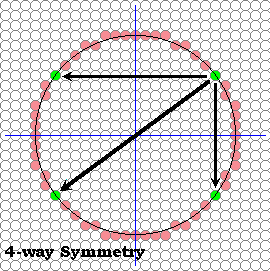Exploiting Symmetry
We could compute the derivative (i.e. slope) at each point and then decide to step in the x or y.
But, let's explore a different approach here.

A circle exhibits a great deal of symmetry.
- Our simple circle-drawing algorithm already exploits 2-way symmetry about the x-axis.
- A circle has even more symmetry.
- For example about the y axis.
|
 |
Lecture 6 |
|
Slide 4 |
|
6.837 Fall '98 |
 |
A circle exhibits a great deal of symmetry. We've already exploited this somewhat
by plotting two pixels for each function evaluation; one for each possible sign of the
square-root function. This symmetry was about the x-axis. The reason that a square-root
function brings out this symmetry results from our predilection that the x-axis should be
used as an independent variable in function evaluations while the y-axis is dependent.
Thus, since a function can yield only one value for member of the domain, we are forced
to make a choice between positive and negative square-roots. The net result is that our
simple circle-drawing algorithm exploits 2-way symmetry about the x-axis.
Obviously, a circle has a great deal more symmetry. Just as every point above an
x-axis drawn through a circle's center has a symmetric point an equal distance from, but
on the other side of the x-axis, each point also has a symmetric point on the opposite side
of a y-axis drawn through the circle's center.